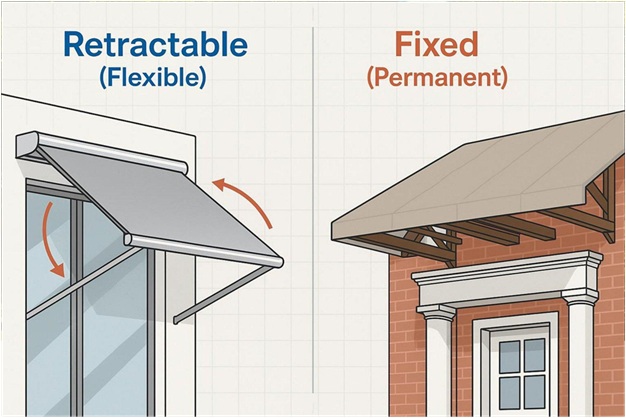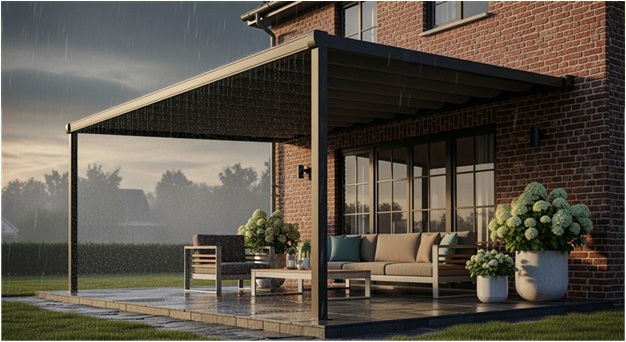If you’re planning to improve your outdoor living space, one key choice you’ll face is whether to get a retractable or fixed sun shade. Both options provide valuable relief from direct sunlight, helping you make your patio, deck, or entrance more comfortable and useful.
However, the two types have different strengths and weaknesses that can affect convenience, flexibility, cost, and how you use your outdoor area. The right sun shade for you will depend on your budget, the way you want to use your outdoor space, and your personal style.
This guide breaks down each option so you can make the best decision for your home in 2025 and beyond.
Retractable and Fixed Sun Shades: What Are They?
Before comparing them, it helps to know what each type of sun shade is. Retractable and fixed sun shades are both made to provide cover and keep away bad weather, but their designs and how you use them are quite different.
Retractable Sun Shade: What Does It Mean?
A retractable sun shade lets you extend or pull back the cover whenever you want, giving you the ability to quickly change how much shade or sun you get. You can operate these systems by hand (with a crank) or automatically (with a motor), and some even allow you to control them through a remote or phone app. Some modern models, such as the Furrion Lumina, use solar power, so you don’t need to worry about extra wiring during installation.
The biggest draw of retractable shades is their versatility. You can enjoy the sunshine when it’s cold, or pull the shade out when it’s hot, making them a smart pick for places where the weather changes a lot. They let you enjoy your space in different ways, no matter the season or time of day.
What about Fixed Sun Shades?
Fixed sun shades, sometimes called stationary or permanent awnings, are built to stay in place all year. Once installed, they provide non-stop cover over places like patios or porches. These shades are often made from strong materials like metal, aluminum, or tough fabrics, so they can handle all types of weather without much fuss.
Since you can’t move or adjust them, fixed shades are best if you want ongoing protection from the sun and rain at any time.
While they can’t be moved like retractable types, their solid build usually makes them very sturdy and they don’t need as much upkeep.

Main Differences: Retractable vs. Fixed Sun Shades
Retractable and fixed shades are not just different because one moves and the other doesn’t. The way they work, how you set them up, and how they look can impact your experience in other ways.
Movement and Control
Fixed awnings are set in place once they’re installed, so you always have shade-even when you might want sunlight. In the winter, this can sometimes block out the warmth of the sun that you’d like indoors.
Retractable awnings give you the power to decide if you want shade or sun anytime. You can roll them out or pull them in based on the weather or your plans for the day. Motorized ones let you use remotes, apps, or voice commands, and some even pull themselves in automatically if sensors detect strong winds.
How They’re Installed
Installation can range from quick and simple to tricky and time-consuming. Some small fixed awnings can be put up by homeowners, but large ones might need extra supports or must meet building codes, so you may want a professional to handle them.
For retractable awnings, especially motorized ones, a professional is usually needed because they have to connect to your home’s electricity. However, solar-powered retractable shades are easier, since you don’t need to deal with wiring-the solar panel runs the motor.
How They Look
Fixed awnings often add a classic look to your home. With different fabric patterns or trim, they can become a permanent part of how your house looks. But keep in mind, fixed awnings always show, so they may look out of date or bulky on some modern homes.
Retractable awnings let you hide them away when you don’t need them, which keeps your home’s appearance neat and modern. Newer models have slimmer cases that hide the parts and keep things looking clean.
Retractable Sun Shades: Advantages
Retractable types are attractive, especially if you like having options and modern features. Here’s why many homeowners choose them:
Easy to Adjust
You can change how much shade or sunlight you get at any time. On hot days, extend the awning; when it’s cooler or cloudy, pull it back. This helps you adapt to weather changes or how you want to use your space at different times.
Improved Comfort Outdoors
By letting you pick how much shade you want, retractable shades help keep outdoor areas cool and pleasant. This means you can use your patio or deck longer each day and even into hotter months. The shade also protects outdoor furniture from fading and sun damage.
Doesn’t Take Up Space When Closed
One of the biggest plusses is that you can tuck the awning away so you don’t block your view or sunlight when you don’t need shade. The shade stores neatly, usually inside its protective case, so your outdoor area can stay as open and bright as you like.
Works with Smart Home Systems
Many new motorized retractable awnings work with smart tech. You can use your phone, a remote, or even your voice to control them. Some models sense strong wind and close by themselves for safety. This automatic feature protects your investment and means less work for you.
Saves on Energy Costs
Using a retractable awning wisely can help cut down your electricity bill. By blocking direct sunlight from hitting large windows or doors, you keep your house cooler, which means the air conditioning doesn’t have to run as much.
In the winter, pulling it back lets in extra sun to warm your home, possibly lowering heating costs. Solar-powered versions save even more because they run off the sun.
Retractable Sun Shades: Drawbacks
Even with all their advantages, retractable sun shades have a few downsides:
They Usually Cost More at First
Retractable awnings, especially with motorization and smart features, are generally more expensive to buy and install than fixed ones. You might expect prices from $8,000 to $25,000 for high-end versions, compared to $5,000 to $20,000 for a typical fixed shade.
They Need More Upkeep
With moving parts and electronics, retractable models need occasional cleaning, oiling, and sometimes repair. Motors or sensors can sometimes fail, adding extra costs, even though warranties are often available.
More Likely to Be Damaged by Bad Weather
Retractable shades need to be pulled in during storms, strong winds, or snow so they aren’t damaged. If you forget or aren’t at home when weather turns suddenly, the awning could be harmed and need repair or replacement.
Wear and Tear with Time
Over time, the fabric or mechanical parts may wear out faster than those on fixed models because of the constant movement and weather exposure. Cheaper models might fade or break sooner, while more expensive ones last longer but still require care.
Fixed Sun Shades: Advantages
Fixed sun shades still have strong selling points-here’s what makes them a good choice for many people:
Constant Protection
Once it’s up, a fixed shade provides ready and reliable shelter from sun and UV rays, every day, all year. This is perfect if you need to block harsh sunlight from certain windows or keep a patio covered for frequent use.
Very Durable
Made from sturdy materials like heavy fabric, steel, or aluminum, fixed shades are designed to stand up to strong winds, rain, and snow. With no moving parts, there’s less that can break. A good fixed shade can last 20 to 30 years with just basic care.
Little Upkeep Required
Most fixed shades only need cleaning from time to time to clear away dirt or mildew. Because there are no motors or gears, maintenance is simple and repair costs are usually low.

Handles All Types of Weather
Because they’re attached firmly and built solidly, fixed shades stay put, even during storms. In places with strong winds or frequent bad weather, this reliability is a major benefit compared to retractable models.
Can Save Money Long-Term
Even if you need to pay for installation or good-quality materials, fixed shades tend to have lower total costs over their lifetime as there are fewer repairs and a longer lifespan.
Fixed Sun Shades: Drawbacks
There are a few reasons why fixed shades can have limitations for some homeowners:
No Flexibility
You can’t adjust a fixed shade, so you always get the same amount of cover. This means you lose out on sunlight during cooler weather or can’t easily adjust coverage as the sun moves during the day.
May Struggle with Heavy Snow or Water
If your region gets lots of rain or snow, a fixed shade will need the right angle and drainage to avoid sagging or damage. Without proper design, water or heavy snow can put stress on the structure or fabric.
Could Block Your View
Because they’re always there, fixed shades might partially block your view of the yard, garden, or scenery from your house. This can be an issue if you value having a clear view outside.
Permanent Decision
Fixed shades are not easily moved or changed. If your tastes or needs change later, it can be difficult and costly to take them down or make changes.
Installation, Space, and Cost
It’s also useful to think about how hard they are to set up, how much space they use, and what they’ll cost in the long run.
Installation Differences
Some fixed shades (like small window covers) can be installed by homeowners, but large or custom covers often need professional help and may require special planning. For retractable types, especially powered ones, a professional is usually best because of wiring and mounting needs. Solar-powered retractable models are easier to add since they don’t need extra electrical connections.
How Much Space Do They Need?
Fixed shades take up permanent space and may change how you use your yard or patio. You should check that you have enough room and that the shade won’t interfere with how you move around or use your plants.
Retractable shades only take up space when open, and remain tucked away when closed. This makes them better if you want the option of an open patio or don’t want to block window light all the time.
Price Guidelines
Prices for sun shades vary by size, materials, and features. On average:
| Type | Usual Price Range |
| Fixed Sun Shade | $5,000 to $20,000 |
| Retractable Sun Shade | $8,000 to $25,000 |
Electric parts, remote controls, smart sensors, and high-end fabrics can make retractable or fixed shades cost more.
Maintenance Expenses
Fixed shades usually need very little maintenance-just cleaning every so often. Retractable types need more regular care, and if something breaks (like a motor or gear), fixing it may be costly. If you use your shade a lot and want advanced features, budget for ongoing service.
When to Pick Retractable or Fixed Sun Shades
Your choice depends on your needs, habits, and where you live.
Retractable Sun Shades Suit:
- People who want to adjust shade as needed.
- Anyone who likes having an open space or clear view when they want it.
- Homes where controlling sunlight helps with heating or cooling.
- People who enjoy new technology, like remote controls or phone apps.
Fixed Sun Shades Are Best for:
- Homes that need continuous shade in one spot, like a busy patio or sunny window.
- People who want a “set it and forget it” solution with almost no upkeep.
- Regions with high winds or frequent storms-fixed shades can usually handle rough weather better.
- Those who want a more affordable and long-lasting option.
Climate Makes a Difference
In places with year-round sun, both options work, but which is best depends on how often you want to change coverage. In areas with lots of storms or very strong winds, fixed shades are usually safer. For variable climates, a retractable shade can help you adjust as needed.
Homes vs. Businesses
While homeowners often focus on style and comfort, restaurants or other businesses might prefer retractable shades to give customers shade when needed and an open feel at other times.
Common Questions
How Long Do They Last?
Fixed shades can last 20-30 years if made from good materials and looked after. Retractable shades usually last 10-20 years, but the moving parts or electrical pieces may need repair or replacement over time.
Which Saves More Energy?
Both can help with cooling, as they block the sun from windows. Retractable models are more flexible because you can open them in winter to let warmth in, saving on heating.
Can I Change a Fixed Shade to a Retractable One?
This usually means taking down the old shade and installing an entirely new retractable system. It often costs as much as buying a new retractable shade from the start.
Do I Need a Professional to Install?
Professional installation is safest-this helps make sure everything is secure and up to code. For electrical or large shades, it also ensures proper setup.
How to Decide: Your Checklist
To choose, ask yourself:
- Do I want to control the amount of shade, or is permanent cover okay?
- Do I want something low-maintenance, or am I willing to do occasional upkeep?
- Is it important that the shade stays strong during storms?
- Am I prepared to pay more upfront for extra features (like smart automation)?
- Do I want a shade that blends in or can be hidden (like a retractable), or is a fixed look fine?
- Is saving energy year-round important, or do I just want summer cooling?
- Do I need the latest smart tech, or are basic functions enough?
- Does blocking the view matter, or do I prefer the shade to disappear when not in use?
The best choice is the one that fits your habits, looks good, and gives you lasting comfort. If you’re unsure, talk to a local expert who can help you pick the right option for your property.






